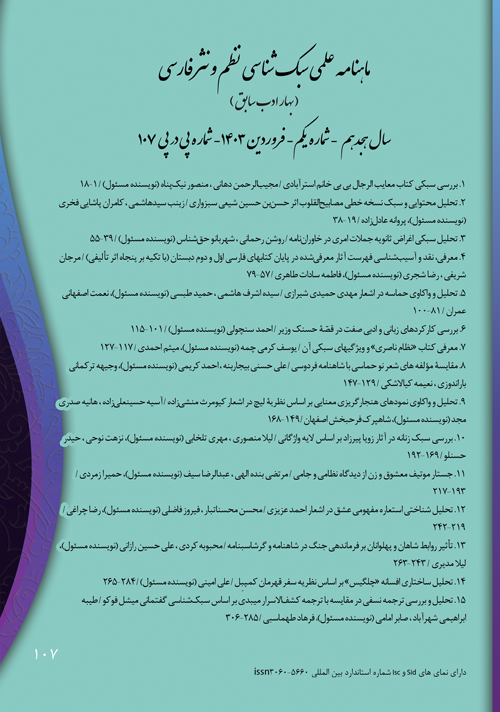- Count View : 155
- آدرس کوتاه شده مقاله: https://bahareadab.com/article_id/1795
- کد doi مقاله: Doi: 10.22034/bahareadab.2025 .18 .7738
Journal of the stylistic of Persian poem and prose
volume Number 18،
number In Volume 1،
،
issue Number 107
Title of the article: Inquiry on the motif of lover and woman from the : Nizami and Jami point of view
Morteza Bandehelahi , Abdolreza Seif (Author in Charge), Homeira Zomorrodi
Abstract
BACKGROUND AND OBJECTIVES: Nizami, in spite of the male thinking of his time, has developed the positive character of women in his stories and has allocated a greater share of the story space to their roles and positive presence. Jami"s point of view about women and her position in all his works and masnavis was not the same, and he sometimes had duality and contradictions in his works. Investigating the motif of mistress and woman in Panj Ganj and Haft Aurang is the main topic of this research. In this article, we have tried to investigate the positive and negative points of thought of poets about women.
METHODOLOGY: The present research is a theoretical study that was conducted in the library research method. The scope and community under study are five Ganj Nizami and Haft Orang Jami, which after collecting the necessary sources and studying each of them, the desired items were extracted and after categorizing the materials, their comparative analysis was done.
FINDINGS: In military masnavis, women have a more praiseworthy identity, although this is not the case in the real world and the times of military life. Military ideas about women, without seeking to exonerate the poet, rather than being influenced by his personal experiences, are a reflection of the perception of the people of his time and the liking of some of the poet"s audience; Otherwise, this misconception is contradictory to what Master Ganjah said about his women, including Afaq and others. Jami has expressed his opinions about women on various occasions in his Masnavis, especially the Masnavis of Yusuf and Zulikha, Laili and Majnoon, Salaman and Absal. Jami has an unpleasant mentality about women, and although he has sometimes praised a chaste woman, he considers her existence as alchemy and impossible.
CONCLUSION: In most of the stories of Five Treasures, the strong presence of women can be seen. They are often honorable and magnificent, and the audience can not only never ignore the presence of women, who always understands their dignity. This presence is very important. Even in some cases, the action of the story revolves around women and they have the main roles of the story. The inherent politeness of this poet prevents him from humiliating women. And he always politely mentions female heroes. In Masnavi Haft Aurang, in Aurang Lili and Majnoon, Jami talks about qualities such as loyalty, tenderness, beauty and self-esteem, but in Aurang Salaman and Absal with a misogynistic view, if he calls a woman beautiful, he calls this beauty a trap and a trick for He has known men"s deception and presented women with the characteristics of: deceit, ignorance, incomplete intelligence, means of men"s lust and unfaithfulness.
Keyword
Nizami
, Jami
, mistress
, woman
- Emami, N. (2021). Injil Ganjai and Panj Ganjai (an inquiry into the life and poetry of Kabir Ganjai with a selection of his poems). First edition. Tehran: Samit, pp. 5-8.
- Afrasiabpour, A. and Fereydoun, T. (2011). Woman from Jami's point of view in Lili and Majnoon. Scientific Research Quarterly on Women and Culture, fourth year, number 15, pp. 87-103.
- Behnam Far, M. and Nazari, A. (2009). Comparative analysis of the story of Dej Hosh Raba with the Red Dome in Haft Paykar Nizami. Tehran: Book of Literature Month, pp. 11-31.
- Jami Khorasani, A. (1999). Haft Orang Edited by Jabalqa Dar Alisha, Tehran: Center for Iranian Studies. pp. 45-755.
- Jami Khorasani, A. (1999). Diwan Jami Introduction and correction by Alakhan Afsahzad. With the Institute of Oriental Studies and the collaboration of written heritage. Tehran: Iranian Studies Center. pp. 805-42.
- Hosseini, M. (2000). Coding of women in mystical literature. Women's Research Quarterly, first year, number 1, pp. 29-45.
- Zanjani, B. (2017). Honorable mention of Ganjavi. Second edition. Tehran: University of Tehran, pp. 15-956.
- Zanjani, B. (2017). Iqbal Name Nizami Ganjoi. Second edition. Tehran: University of Tehran, pp. 9-536.
- Zanjani, B. (2018). Khosrow and Shirin Nizami. Third edition. Tehran: University of Tehran, pp. 12-1021.
- Modares Gilani, M. (2018). Masnavi Haft Aurang. Tehran: Mehtab, pp. 1051-54.
- Miles Hervey, N. (2010). Sheikh Abdul Rahman Jami. Tehran: New Design, pp. 14-313.
- Nizami, G. (2006). Reservoir of secrets. Edited by Hassan Vahid Dastgardi, with the efforts of Saeed Hamidian. Tehran: Qatre, pp. 8-215.
- NizamI, G. (2016), Laili and Majnoon, edited by Hassan Vahid Dastgerdi, with the effort of Saeed Hamidian. Tehran: Drop, pp. 275-6.
- Nizami, G. (1997). Seven bodies. Edited by Hassan Vahid Dastgardi, with the efforts of Saeed Hamidian. Tehran: Drop, pp. 19-418.
- Wasfi, Z. (1970). Beginnings of events. Edited by Alexander Beldrov, Tehran: Iran Culture Foundation, pp. 12-555.
- Navai, A. (1984). Majlis al-Nafis Translations by Fakhri Heravi and Shah Mohammad Qazvini, by Ali Asghar Hekmat. Tehran: Manochehri, pp. 11-508.

